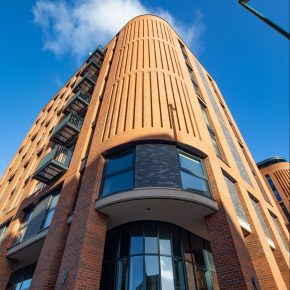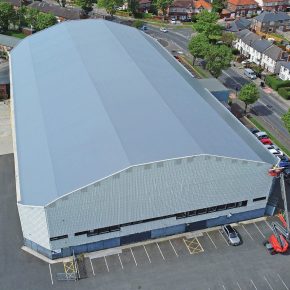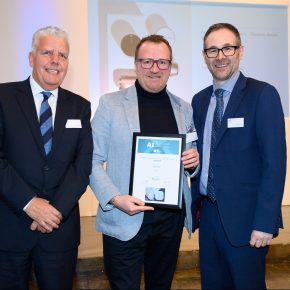
Sustainable Drainage Systems fall under new legislation
Long-awaited new legislation will enable new local authority SuDS Approving Bodies (SABS) in England and Wales to officially start work approving and adopting SuDS proposed for new developments of more than property. The regulations will end a developer’s automatic right to connect to a public sewer.
SuDS are often designed to achieve the three principles of the so-called SuDS triangle of water quantity, water quality and amenity/ biodiversity
The SAB responsibility is an important new role for the Lead Local Flood Authorities established in the wake of the Pitt Review, which set out to improve the country’s resilience to surface water flooding in the wake of 2007’s devastating floods.
SuDS first principles
The principles of SuDS are first and foremost to mimic natural drainage and deal with rainwater as close as possible to where it falls. SuDS avoid costly and unsustainable transportation of surface water run-off in an overloaded combined sewer system.
SuDS are often designed to achieve the three principles of the so-called SuDS triangle of water quantity, water quality and amenity/ biodiversity. SuDS will often include a number of different features where this is practical which could be combined in a so-called management train to meet water quantity and quality stipulations for the site.
A SuDS design may include natural SuDS features such as ponds, wetlands or swales and/or proprietary manufactured systems such as vortex flow controls or hydrodynamic separators. The construction and highways industries are gaining a greater understanding of how to apply and combine the best techniques from the SuDS toolbox successfully.
While the techniques for volume control to meet discharge consents are well known, some engineers and contractors may require guidance to understand the options and best practice approaches for treatment.
The choice of SuDS features depend on the site and ground conditions, available land, construction costs and future maintenance and adoption
In England and Wales detailed new guidelines are being developed as part of the legislative framework to provide designers and developers with good guidance. An update to the widely-recognised SuDS Manual published by the Construction Industry Research Information Association is also expected in the near future.
Surface water treatment
The new legislation in England and Wales will, for the first time, introduce mandatory requirements for surface water treatment to remove silts, sediments and pollutants from surface water run-off. However, Scotland is widely considered to be ahead with SuDS as a result of legislation first established more than ten years ago, especially for surface water quality.
As a recent survey conducted by the SuDS knowledge-sharing website Engineering Nature’s Way shows, experience in Scotland points the way for England and Wales and holds some important lessons particularly in relation to the adoption and ongoing maintenance of SuDS features. A full report of the survey can be downloaded from the Engineering Nature’s Way website.
Key considerations for SuDs success
Key considerations that influence the optimum choice of SuDS features depend on factors such as the site and ground conditions, available land, construction costs and future maintenance and adoption.
Natural SuDS design may include ponds, wetlands or swales and proprietary manufactured systems such as vortex flow controls or hydrodynamic separators
Accurately judging both initial capital and through-life costs will continue to present challenges for both designers and developers of SuDS. It will be important to define the maintenance requirements for vegetated features such as ponds or wetlands alongside manufactured elements of a drainage scheme such as a vortex separator.
For manufactured devices, providing a proven, predictable maintenance schedule and costs is straightforward. But how will the full costs and maintenance schedule of a pond be accurately defined? I believe adopting authorities could take a few years to truly get to grips with the full operational, maintenance and cost implications of SuDS under their jurisdiction.
Tip of the iceberg
The need to retrofit SuDS in our urban environments to protect already-overloaded sewer networks and improve water quality is not yet covered by legislation. So, while celebrating the achievement of SuDS legislation for England and Wales, it should be remembered that this is just the tip of the iceberg in seeing SuDS on every urban street corner. There is still a long way to go
Latest news

23rd April 2024
Mitsubishi Electric Ecodan Heat Pumps and Water Cylinders to be stocked by The Boiler Shop
Mitsubishi Electric’s full range of Ecodan heat pumps and hot water cylinders are to be stocked by one of the north-west’s best established independent merchants, The Boiler Shop.
Posted in Articles, Building Industry News, Building Products & Structures, Building Services, Facility Management & Building Services, Heating Systems, Controls and Management, Heating, Ventilation and Air Conditioning - HVAC, Plumbing, Posts, Retrofit & Renovation, Sustainability & Energy Efficiency
23rd April 2024
Trio of Senior products used in new Nottingham residential scheme
Solutions from Senior Architectural Systems have helped complete The Barnum – a new residential development on Nottingham’s Queen’s Road.
Posted in Aluminium Products, Articles, Building Industry News, Building Products & Structures, Building Systems, Case Studies, Curtain Walling, Doors, Glass, Glazing, Posts, Restoration & Refurbishment, Retrofit & Renovation, Walls, Windows
22nd April 2024
New EJOT role will develop strategic support for UK flat roofing sector
EJOT UK has taken a major step in the expansion of its support for the flat roofing market by appointing one of its most experienced building envelope fastening specialists as its first sector-dedicated business development manager.
Posted in Articles, Building Industry News, Building Products & Structures, Building Systems, Innovations & New Products, Posts, Recruitment, Restoration & Refurbishment, Retrofit & Renovation, Roofs
22nd April 2024
Access2 Wins ADSA-Sponsored Award at AI Specification Awards
Access2 clinched the ADSA-sponsored Product Design and Innovation Award (Electronic) at the AI Specification Awards 2024 on Thursday.
Posted in Access Control & Door Entry Systems, Architectural Ironmongery, Articles, Awards, Building Associations & Institutes, Building Industry Events, Building Industry News, Building Products & Structures, Building Services, Doors, Facility Management & Building Services, Information Technology, Innovations & New Products, Retrofit & Renovation, Security and Fire Protection, Video of the Week
 Sign up:
Sign up: